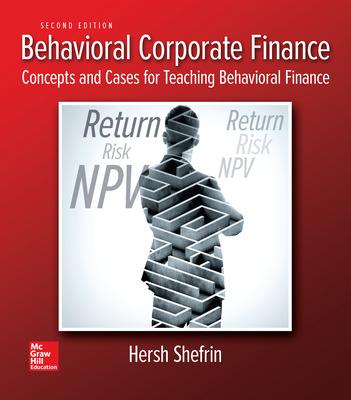Based on the information presented in the minicase, how would you characterize PSINet CEO William Schraders susceptibility
Question:
- Based on the information presented in the minicase, how would you characterize PSINet CEO William Schrader’s susceptibility to psychological phenomena?
- Discuss the extent to which PSINet’s financing and investment decisions conform to the BPV framework presented in the chapter.
- In your view, how similar is the personality of Cogent Communications CEO Dave Schaeffer to the personality of PSINet CEO William Schrader?
- Discuss the extent to which Cogent’s financing and investment decisions conform to the BPV framework presented in the chapter.
- Analyze the ratio that Cogent Communication uses to measure leverage, and compare it to common textbook ratios measuring leverage.
In 1999, entrepreneur David Schaeffer founded the net- working firm Cogent Communications, and thereafter served as its Chairman, Chief Executive Officer, and President. Schaeffer initially wrote a business plan under the premise that the Internet was going to be the only net- work that mattered. At the time, most of the networks that carried Internet traffic were telephone and cable television networks, but their architectures were inefficient for carrying Internet traffic. Schaeffer’s plan was to con- struct a global network to deliver the Internet efficiently that worked like a cheap office network, essentially built around nothing more than routers manufactured by Cisco Systems along with some fiber optic cable. He estimated that constructing such a network would cost approximately $2 billion.
Cogent initially raised $26 million from six venture capital firms, which led many large equipment manufacturers to offer the firm generous vendor financing deals. Schaeffer accepted an offer from Cisco whereby for every $1 of Cisco gear that Cogent purchased, Cisco would lend Cogent $1.40. As a result of this arrangement, Cogent had a $409 million credit line.
In the autumn of 2000, an economic downturn in the wake of the collapse of the dot.com bubble led many network firms to experience financial distress. In 2001, drawing on its credit line, Cogent acquired the assets of the firm NetRail. In early 2002, Schaeffer merged his firm with Allied Riser, which wired large office buildings with fiber optic cable, effectively trading 13 percent of Cogent for $132 million in net cash and 100 percent of Allied Riser’s fiber network.
In April 2002, Cogent acquired PSINet, a firm in bankruptcy, with an interesting history. PSINet went public in 1995 and raised $46 million. Shortly thereafter, PSINet began to serve business customers, establishing 100,000 business accounts in 27 countries. The firm undertook a strategy to run one of the world’s largest networks, linked to a massive number of PSINet-owned web-hosting centers.
At the time, PSINet’s debt load increased 36-fold, from $112 million to $4 billion. Its annual interest obligations went from being $5 million in 1997 to being $400 million in 2000. In April 1998, for the first time in its history, PSINet issued debt that was below investment grade (junk), selling $600 million in bonds paying 10 percent.
The firm then made a series of large investments: It spent $34 million for new headquarters, purchased a corporate jet, and agreed to pay $90 million in order to have the new Baltimore Ravens football stadium bear its name. The cover story in the May 28, 2001, issue of Forbes magazine describes how PSINet’s CEO, William Schrader, and its board of directors assessed the firm’s financing strategy.
“We knew we were going to be heavy on the debt side, light on the equity side,” says William Baumer, a board member and an economist who heads the University of Buffalo’s philosophy department. “The assessment was that...
Step by Step Answer:

Behavioral Corporate Finance Concepts And Cases For Teaching Behavioral Finance
ISBN: 9781259277207
2nd Edition
Authors: Hersh Shefrin





